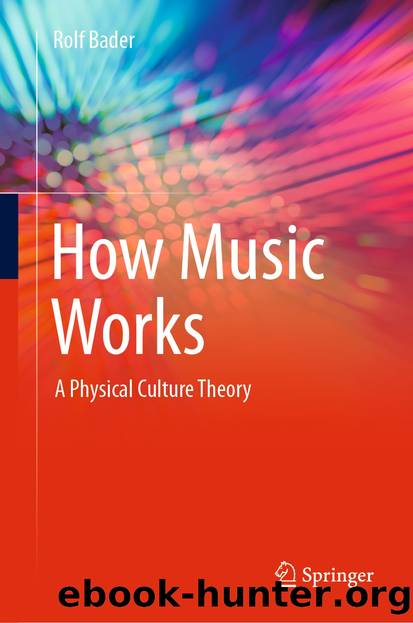How Music Works by Rolf Bader

Author:Rolf Bader
Language: eng
Format: epub
ISBN: 9783030671556
Publisher: Springer International Publishing
Free Reed Instruments
When traveling through Northern Thailand or in Yunnan, Southwest China, in Laos or some eastern parts of Myanmar (formally Burma), one can experience the fascinating sound of mouth organs, the khaen,58 the hulusheng,59 the sheng, as it is called in mainland China, or the sho in Japan. These instruments have multiple pipes that lay next to each other, with their lower ends attached to a gourd or other kinds of small wind chambers. Within each pipe, a small reed can freely vibrate up and down. It is driven by the air pressure in the wind chamber, which again is caused by the player blowing into the instrument. Each pipe has one finger hole at its side where the player places fingers on.
One fascinating thing is that if one is blowing into the wind chamber with all finger holes open, there is no sound at all. Only if one is closing a hole this pipe will start sounding in its pitch. This is convenient as if all pipes would always sound at the same time if driven by the player. Of course, the player wants to play melodies and therefore needs to be able to choose which pitches to play.
The pipe is not sounding because the open finger hole at its side is placed such that it disturbs the impulse caused by the reed, traveling down the pipe so strongly that the pipe cannot sound at all. The reason for this is not perfectly clear and up to investigation [13].
Still, another thing is even more interesting with this instrument. If the blowing pressure of the player is low, the pipes are indeed sounding, no matter if the finger hole at the side is open or not! The pitch of each pipe then is different from the pitch when the pipes are played with regular strong blowing pressure. So each pipe has two pitches, one with high and one with low blowing pressure.
The reason for this behavior becomes more clear, as we find that the pitch with strong blowing (and closed finger hole) is that of the pipe, caused by the length of the pipe, while the pitch with low blowing pressure is caused by the pitch the reed has when vibrating on its own without a pipe attached. Therefore with high blowing pressure, the reed is forced to vibrate with the pitch of the pipe length, and with low blowing pressure, the reed can vibrate on its own and forces the pipe to vibrate with the pitch of the reed.
So again, we have a nice example of a self-organizing instrument, where one vibrating system is forcing the other into its frequency. We also have two options of who is slaving whom, depending on the blowing pressure. And again, we have a sudden change between both cases, at a certain blowing pressure, the situation changes suddenly, and the slaving is turned around. We also have the hysteresis loop again, where one needs more blowing pressure to turn from the reed
Download
This site does not store any files on its server. We only index and link to content provided by other sites. Please contact the content providers to delete copyright contents if any and email us, we'll remove relevant links or contents immediately.
The Goal (Off-Campus #4) by Elle Kennedy(13220)
Kathy Andrews Collection by Kathy Andrews(11357)
Diary of a Player by Brad Paisley(7275)
What Does This Button Do? by Bruce Dickinson(5941)
Assassin’s Fate by Robin Hobb(5871)
Big Little Lies by Liane Moriarty(5532)
Altered Sensations by David Pantalony(4882)
Pale Blue Dot by Carl Sagan(4647)
Sticky Fingers by Joe Hagan(3922)
The Death of the Heart by Elizabeth Bowen(3355)
The Heroin Diaries by Nikki Sixx(3339)
Beneath These Shadows by Meghan March(3162)
Confessions of a Video Vixen by Karrine Steffans(3118)
The Help by Kathryn Stockett(3024)
How Music Works by David Byrne(2976)
Jam by Jam (epub)(2889)
Harry Potter 4 - Harry Potter and The Goblet of Fire by J.K.Rowling(2830)
Strange Fascination: David Bowie: The Definitive Story by David Buckley(2706)
Petty: The Biography by Warren Zanes(2583)
